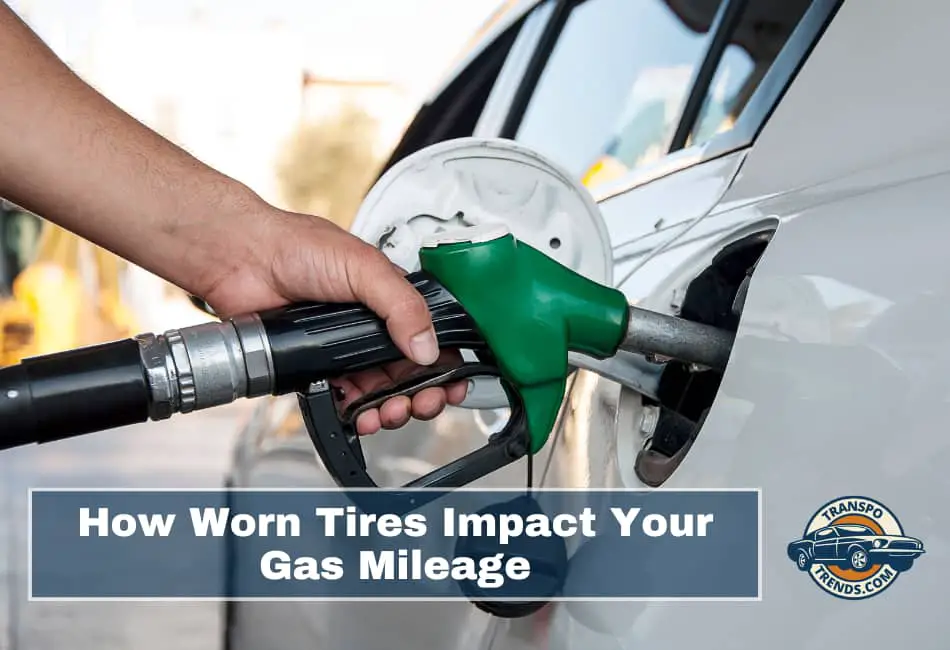As tires wear down, they can quietly drain your gas tank, leading to higher fuel costs and a larger environmental footprint.
In this guide, we will explore the relationship between tire treadwear and fuel efficiency, explaining how worn tires increase rolling resistance and lead to higher fuel consumption.
We will also share actionable tips on maintaining proper tread depth and choosing tires designed to improve gas mileage.
Understanding Rolling Resistance and Fuel Efficiency
Rolling resistance is the force that opposes a tire’s motion as it rolls on the road, and it is a key factor in determining how much fuel your vehicle consumes.
When rolling resistance is high, your engine must work harder to keep the car moving, burning more fuel in the process.
Tires are carefully designed with specific tread patterns, rubber compounds, and inflation levels to balance rolling resistance with traction and durability.
However, as tires wear down, these engineered properties can change, often increasing the energy needed to move your vehicle.
Worn tires can develop uneven wear patterns or lose their ability to grip the road effectively, which increases rolling resistance.
This means your vehicle uses more fuel to maintain speed, especially in challenging conditions like wet roads or uneven surfaces.
According to the U.S. Department of Energy, tires account for 20-30 percent of a vehicle’s fuel consumption, making their condition a critical factor in gas mileage.
How Worn Tires Impact Fuel Efficiency
Worn tires can reduce fuel efficiency through several mechanisms, each contributing to higher fuel consumption in its own way:
Reduced Traction
As tread depth decreases, tires lose their ability to grip the road, particularly in wet or slippery conditions. This reduced traction can cause slipping or skidding, forcing your engine to work harder to maintain control and speed.
When your tires struggle to grip, the engine compensates by using more energy, which increases fuel consumption.
The U.S. Department of Energy highlights that worn tires are more likely to slip, requiring the engine to expend extra energy to keep the vehicle moving.
Uneven Wear Patterns
Worn tires often develop uneven wear patterns, such as cupping—small dips in the tread—or excessive shoulder wear.
These patterns can increase rolling resistance by causing the tire to flex more as it rolls. This extra flexing generates heat and requires more energy from the engine, reducing fuel efficiency.
Uneven wear can also lead to vibrations, which further strain the vehicle’s systems and contribute to higher fuel use.
Underinflation Risks
Worn tires may lose air pressure more quickly, leading to underinflation. Underinflated tires have a larger contact patch with the road, which increases rolling resistance and decreases fuel efficiency.
The U.S. Department of Energy estimates that underinflated tires can reduce gas mileage by up to 3.3 percent, a significant impact over time. Worn tires are more prone to this issue, as their structure may not hold air as effectively as new tires.
Misalignment and Imbalance
Worn tires can contribute to wheel misalignment or imbalance, causing your vehicle to drag slightly as it moves. This drag increases rolling resistance, forcing the engine to work harder and burn more fuel.
Misaligned tires, often a result of uneven wear, can create unnecessary friction, further reducing fuel efficiency. Regular maintenance can help catch these issues early, ensuring your tires perform at their best.
Research from the National Academies Press suggests that rolling resistance can decrease by 20-26 percent over a tire’s wear life due to reduced tread mass, potentially improving fuel efficiency by 2-5.2 percent in controlled conditions.
However, in real-world driving, factors like reduced traction, misalignment, and imbalance often outweigh this benefit, leading to increased fuel consumption for most drivers.
For the average motorist, worn tires are more likely to decrease fuel efficiency due to these practical challenges.
Maintaining Proper Tread Depth for Better Fuel Efficiency
Ensuring your tires have adequate tread depth is essential for both fuel efficiency and safety. A simple way to check tread depth is the penny test: insert a penny into the tread groove with Lincoln’s head upside down.
If you can see the top of his head, the tread depth is below 2/32 of an inch, and it is time to replace the tire. Many tires also feature treadwear indicators—small rubber bars that become visible when the tread reaches 2/32 of an inch, signaling the need for replacement.
In the United States, the legal minimum tread depth for passenger vehicles is 2/32 of an inch, but replacing tires before they reach this point can help maintain fuel efficiency and safety.
Adequate tread depth ensures your tires can grip the road effectively, reducing the energy needed to move your vehicle.
It also helps prevent safety issues like hydroplaning, which can occur when tread is too worn to channel water away from the tire’s surface.
By keeping your tread depth in check, you can optimize fuel economy and drive with greater confidence.
| Tread Depth | Condition | Action |
|---|---|---|
| Above 4/32 inch | Good | Continue regular maintenance |
| 2/32 – 4/32 inch | Fair | Monitor closely, consider replacement soon |
| Below 2/32 inch | Worn | Replace immediately |
This table offers a quick reference for assessing your tire condition and taking appropriate action to maintain fuel efficiency.
Choosing Tires with Low Rolling Resistance
When it is time to replace your tires, consider opting for those designed with low rolling resistance to maximize fuel efficiency.
These tires use advanced tread designs and materials, such as silica-based compounds, to minimize energy loss as the tire rolls.
Look for tires labeled as “fuel-efficient” or check the Uniform Tire Quality Grading (UTQG) rating, where a higher treadwear number often indicates better durability and efficiency.
For example, a UTQG treadwear rating of 600 suggests a tire will last longer and potentially offer better fuel economy than one rated at 300.
All-season tires are a popular choice for balanced performance across various conditions, but if you drive in specific climates, specialized tires may provide better fuel efficiency.
For instance, summer tires with low rolling resistance can optimize gas mileage in warm weather, while winter tires may increase fuel use due to their softer compounds and aggressive treads.
Always select tires that match your driving habits and climate to maximize efficiency. Choosing the right tires can make a noticeable difference in your fuel costs over time.
Practical Tips for Improving Fuel Efficiency Through Tire Care
Proper tire maintenance is key to optimizing fuel efficiency and extending tire life. Here are some actionable steps to help you get the most out of your tires:
Check Tire Pressure Monthly
Use a reliable gauge to ensure your tires are inflated to the recommended pressure, which is typically found on the vehicle’s placard, often located on the driver’s door jamb.
Proper inflation reduces rolling resistance and can improve gas mileage by up to 3.3 percent, according to the U.S. Department of Energy.
Check your pressure at least once a month and before long trips, adjusting as needed to account for temperature changes.
Rotate Tires Regularly
Rotating your tires every 5,000 to 7,000 miles helps promote even wear across all four tires, preventing uneven patterns that can increase fuel consumption.
Use a forward cross pattern—swapping front left with rear right, and front right with rear left—or an X-pattern, swapping front left with rear left, and front right with rear right, to ensure uniform wear.
Align Wheels
Have your wheels aligned every year or 6,000 miles, or sooner if you notice uneven wear or if your vehicle pulls to one side.
Proper alignment minimizes drag, which can otherwise increase rolling resistance and reduce fuel efficiency. Regular alignments also help extend tire life by ensuring even wear.
Avoid Overloading
Stay within your vehicle’s load capacity to prevent excessive tire wear and increased fuel use. Check the load rating on the tire sidewall or vehicle placard to ensure you are not overloading your tires. Distributing weight evenly can also help reduce strain and maintain efficiency.
Drive Smoothly
Avoid rapid acceleration and hard braking, as these habits can accelerate tire wear and reduce fuel efficiency.
Smooth driving not only saves on fuel but also helps your tires last longer, giving you more value for your investment.
Debunking Common Myths About Tires and Fuel Efficiency
Several myths about tires and fuel efficiency can lead to confusion. Let us clear up a few common misconceptions:
- Myth: Larger Tires Are Always Less Fuel-Efficient
While larger tires can increase rolling resistance, they may improve fuel efficiency at high speeds on highways by covering more ground per rotation. For most drivers, however, smaller tires are more fuel-efficient, especially in city driving. - Myth: All-Season Tires Are Always the Best Choice
All-season tires offer balanced performance, but specialized tires may be more fuel-efficient in extreme conditions. For example, summer tires can optimize gas mileage in hot weather compared to all-season tires. - Myth: Worn Tires Are More Fuel-Efficient
While worn tires may have slightly lower rolling resistance in controlled conditions, real-world factors like reduced traction, misalignment, and imbalance typically increase fuel consumption. Replacing worn tires with new, fuel-efficient ones is the better choice.

